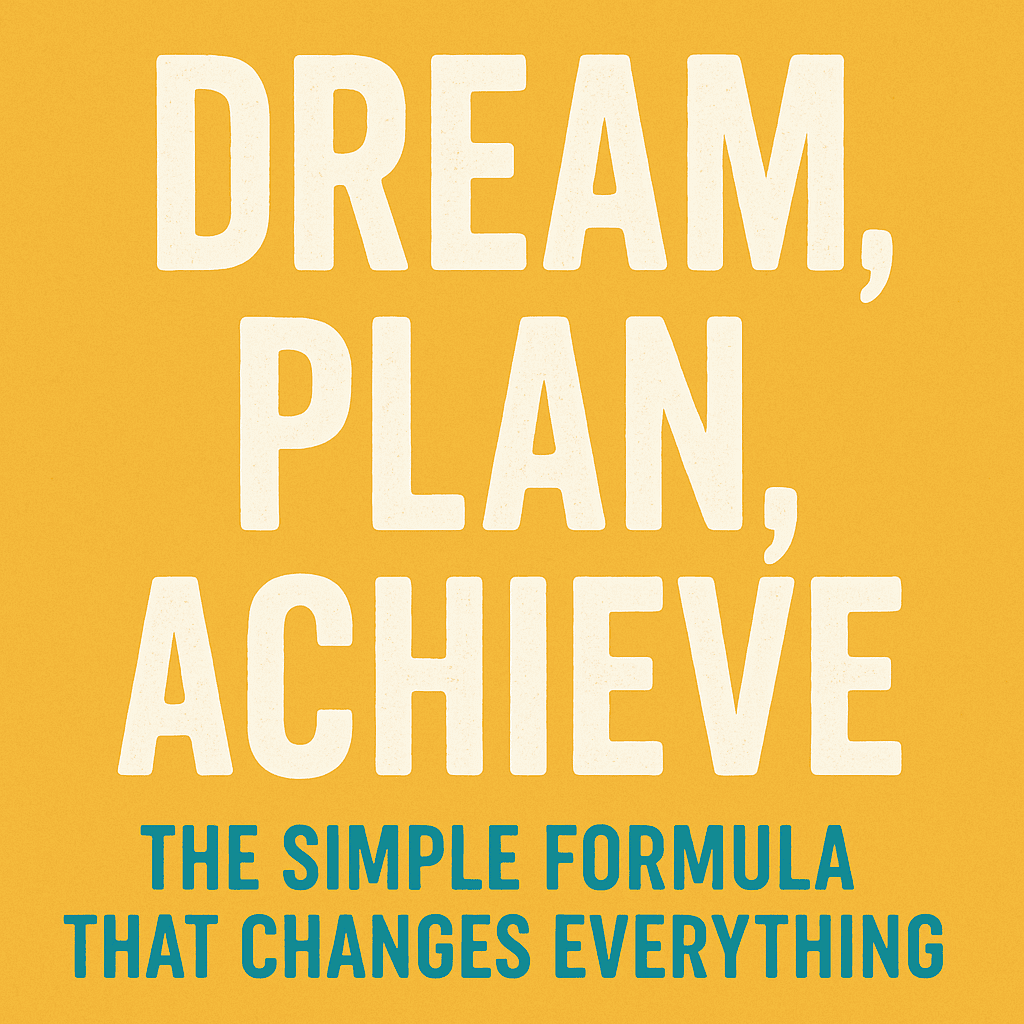Have you ever watched someone completely transform their life and wondered how they did it? Maybe it was a colleague who landed their dream job, a friend who finally launched their business, or someone who ran their first marathon after years of thinking about it. What separates the people who make things happen from those who keep talking about what they want to do someday?
The answer isn’t luck, talent, or connections – though those things can help. The real secret lies in a simple three-step process: Dream, Plan, Achieve. This isn’t just another motivational slogan you see on office posters. It’s a proven goal setting framework that successful people use to turn their biggest aspirations into reality.
Whether you’re looking to advance your career, start a side project, improve your health, or make any meaningful change in your life, this achievement approach can help you get there. We’re going to break down each step, show you how they work together, and give you practical tools to start using this success planning system right away.
Why Most People Get Stuck Before They Even Start
Let’s be honest – we all have dreams. Maybe you want to switch careers, learn a new skill, travel more, or build something meaningful. But here’s what happens to most people: they think about their dreams for a while, maybe talk about them with friends, and then… nothing. Life gets busy, doubts creep in, and those dreams get pushed to “someday.”
The problem isn’t that people don’t want things badly enough. The problem is they skip the crucial middle step – planning. They go straight from dreaming to trying to achieve, which is like trying to build a house without blueprints. You might make some progress, but you’ll waste time, money, and energy, and you probably won’t end up with what you wanted.
The Dream, Plan, Achieve framework works because it recognizes that each step serves a specific purpose in personal development. Dreams give you direction and motivation. Plans give you a roadmap and clear actions. Achievement gives you results and confidence to dream bigger next time. When you use all three steps together in this goal achievement process, magic happens.
The Art of Dreaming: More Than Just Wishful Thinking
When most people hear “dream,” they think about vague wishes or fantasies. But effective dreaming is actually a skill that requires some thought and intention. It’s about getting clear on what you really want, not what you think you should want or what looks good on paper.
Good dreams have a few key qualities in any success mindset. They excite you when you think about them. They feel challenging but possible. They align with your values and what matters to you. And they’re specific enough that you can picture what success looks like.
Let’s say you have a general desire to “be more successful at work.” That’s a start, but it’s not specific enough to drive action planning. A better dream might be: “I want to become a team leader in my department within the next two years because I love mentoring others and want to have more influence on our projects.”
The difference is huge for career advancement goals. The first version is fuzzy and hard to measure. The second version is clear, has a timeline, and explains why it matters to you. When you get specific about your dreams, your brain starts looking for opportunities to make them happen.
Getting Past the Dream Killers
Here’s what usually happens when people start dreaming bigger: their inner critic shows up. You know that voice – the one that says you’re not qualified enough, smart enough, or experienced enough. It tells you to be “realistic” and stick with what you know.
This voice isn’t trying to hurt you. It’s trying to protect you from disappointment and failure. But if you listen to it too much, you’ll never grow beyond where you are right now in your personal growth journey.
The key is to acknowledge these doubts without letting them stop you. Yes, there will be challenges. Yes, you might fail. But you might also succeed in ways you never imagined. Some of the best opportunities come to people who were willing to dream beyond their current circumstances.
Try this exercise: write down your dream, then write down all the reasons it won’t work. Look at that list and ask yourself: which of these are real obstacles, and which are just fears? Real obstacles can be planned around. Fears just need to be faced.
The Planning Phase: Where Dreams Meet Reality
This is where most people either make it or break it in their goal setting journey. Dreaming is fun and easy. Achieving feels good when it happens. But planning? That’s work. It requires you to break down your big, exciting dream into smaller, sometimes boring action steps. It means doing research, learning new skills, and facing the gap between where you are and where you want to be.
But here’s the thing about success planning – it’s what makes the difference between people who achieve their goals and people who just talk about them. A good plan turns your dream from something abstract into something concrete you can work on every day.
Breaking Down the Big Picture
Start by working backward from your dream in this transform your life through planning approach. If your goal is to become a team leader in two years, what needs to happen in the next 18 months? The next year? The next six months? Keep breaking it down until you have actions you can take this week and this month.
For the team leader example, your career development goals plan might look like this:
- This month: Schedule a conversation with your current manager about career development opportunities
- Next three months: Take on a small project leadership role or volunteer to mentor a new team member
- Next six months: Complete a leadership training program and start building relationships with other department leaders
- Next year: Apply for leadership opportunities that open up and continue developing your management skills
- 18 months: Position yourself as the obvious choice when team leader roles become available
Each step builds on the previous one and moves you closer to your dream. Without this breakdown, you might wait two years hoping a leadership opportunity falls in your lap. With it, you’re actively creating the conditions for success.
Planning for the Unexpected
Life has a way of throwing curveballs at our carefully made plans. The key is to build flexibility into your approach. Think about potential obstacles and have backup plans ready. What if your company restructures? What if a family situation requires your attention? What if you discover your dream isn’t quite what you thought it would be?
Good planning doesn’t mean controlling every detail. It means being prepared to adapt while staying focused on your end goal. Sometimes the path changes, but the destination stays the same.
Making It Happen: The Achievement Phase
This is where your dreams and plans get tested in the real world. Achievement isn’t just about reaching your final goal – it’s about consistently taking the actions your plan requires, even when you don’t feel like it.
The achievement phase is full of small, daily choices that drive life transformation. Do you have that conversation with your manager, or do you put it off another week? Do you sign up for that training program, or do you tell yourself you’ll do it later? Do you network with other leaders, or do you stay in your comfort zone?
Success comes from making the right choice more often than not. You don’t have to be perfect – just consistent. Each action you take builds momentum and gets you closer to your dream.
Dealing with Setbacks and Obstacles
Here’s what nobody tells you about achievement: it rarely goes according to plan. You’ll face rejection, obstacles, and moments when you want to quit. This isn’t a sign that you’re on the wrong path – it’s just part of the process.
When setbacks happen, go back to your plan. Can you adjust your timeline? Do you need to learn new skills? Should you try a different approach? Most problems have solutions if you’re willing to get creative and persistent.
Remember why you started. Your original dream probably hasn’t changed, even if the path to get there needs some adjustments. Keep that vision in front of you when things get tough.
Celebrating Progress Along the Way
Don’t wait until you achieve your final dream to celebrate. Recognize the small wins along the way – the skills you develop, the relationships you build, the confidence you gain. These victories keep you motivated and remind you that you’re making progress even when the end goal still feels far away.
Maybe you didn’t get the promotion you wanted, but you did complete that leadership training and earned respect from your colleagues. Maybe your side business isn’t profitable yet, but you did launch your website and get your first customers. These steps matter just as much as the final achievement.
Putting It All Together: Your Personal Success System
The Dream, Plan, Achieve approach works best when you use it as an ongoing cycle, not a one-time process. Once you achieve one goal, you can dream bigger, plan better, and achieve more. Each success builds confidence and skills that help you tackle even bigger challenges.
Start small if you need to. Pick something you want to achieve in the next three to six months. Dream about what success would look like and why it matters to you. Make a detailed plan with specific actions and deadlines. Then start taking those actions consistently.
As you get comfortable with the process, you can apply it to bigger dreams and longer timelines. The skills you develop – clear thinking, strategic planning, consistent action – will serve you in every area of your life.
Building Your Support System
Achievement doesn’t happen in isolation. Think about who can support you on your journey. Maybe it’s a mentor who can give you advice, a friend who can hold you accountable, or a professional network that can provide opportunities. Don’t be afraid to ask for help when you need it.
Share your dreams and plans with people who believe in you and want to see you succeed. Their encouragement can make the difference on days when your motivation is low.
Making This Your Reality
The Dream, Plan, Achieve framework isn’t complicated, but it requires commitment. You have to be willing to dream bigger than your current circumstances, put in the work to create detailed plans, and take consistent action even when progress feels slow.
The good news is that this approach gets easier with practice. Each time you complete the cycle, you build confidence in your ability to make things happen. You start to see obstacles as challenges to overcome rather than reasons to quit. You develop the mindset of someone who doesn’t just hope for good things to happen – someone who makes them happen.
What dream have you been putting off? What would be different in your life if you stopped waiting for the perfect moment and started taking action today? The Dream, Plan, Achieve process isn’t magic, but the results can feel magical when you commit to using it consistently.
Your dreams are waiting for you to take them seriously. It’s time to stop wishing and start planning. It’s time to stop planning and start doing. Your future self will thank you for taking that first step today.




